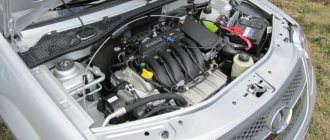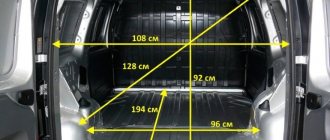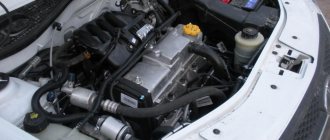Largus width with mirrors
Dimensions of openings and clearances of mating parts of the LARGUS body
Mounting points for suspensions on the body
1 — front subframe mounting points; 2 — mounting points for the shock absorber strut; 3—rear subframe mounting points; 4 — guide holes of the front spar; 5 — front guides of the rear spar; 6 — guide holes for mounting the rear suspension; 7 — rear suspension mounting holes; 8 - holes for mounting the rear shock absorber; 9 — rear guide holes of the rear spar.
Scheme for measuring interaxial dimensions
Before: -1: (B1) - (G2) = (B2) - (G1) -2: (G1) - (C2) = (G2) - (C1)
Rear: -1: (G2) - (B1) = (G1) - (B2) -2: (B1) - (J2) = (B2) - (J1)
Advantages and disadvantages
To make the right decision, you need to study not only the advantages, but also the disadvantages of the model. The owners, who have extensive experience in operating Largus, found one drawback. The car manufacturer did not adjust the interior of the station wagons in such a way that their owners would have the opportunity to transport large loads. If the driver nevertheless decided to load a large object into his car, then the cargo often caused damage to the interior.
Otherwise, Lada Largus owners are satisfied with everything in their cars. Among the advantages of a Russian car are the following:
- ease of loading;
- optimal dimensions;
- the ability to increase trunk capacity by removing the seats;
- high load capacity;
- possibility of modernization.
Drivers universally note the practicality and convenience of the LADA Largus trunk. Its size is quite enough to demonstrate the functionality of a domestic car, which allowed it to become a leader among its closest competitors. The manufacturer managed to competently and rationally approach the arrangement of the body space, which allows Largus to successfully transport large objects and indicates the enviable carrying capacity of the model.
Basic dimensions
The main indicators of the dimensions of any car, first of all, are understood as the dimensions of the body. Everyone knows that Lada-Largus is a model made on the Renault Dasia Logan MSV platform (2006 variation), but completely adapted for the Russian market. Considering such a relationship between the two cars, it seems surprising that there are some differences in their dimensions, even if they are not significant.
Despite the fact that the Lada-Largus is available in three body variations: a station wagon (5 seats), a minivan (7 seats) and a van (2 seats) - the dimensions of all variations are the same, with the exception of height. More precisely, the machine dimensions are as follows (in mm):
- length – 4470;
- width – 1750;
- width including side mirrors – 2003;
- height – 1636 (station wagon/minivan) and 1650 (van);
- height taking into account restylings - 1670 (station wagon/minivan) and 1686 (van);
- ground clearance - 145-175, which depends on the load of the car (210-170 - for Lada-Largus Cross);
- wheelbase - 2900;
- front track - 1469;
- rear track - 1466;
- front/rear overhangs – 797/771.
Having analyzed the dimensions of the car, we can conclude that the car is quite large for a B-class. Such circumstances emerge not only in theory, but also in practice, judging by the reviews of the owners. Many of them note that the dimensions fit quite well into the aesthetic concept of the car and do not cause any inconvenience during its operation.
Increasing the volume of the cargo compartment (removing the excess part on the floor)
The cargo compartment volume of the Lada Largus van can be increased. To do this, remove the floor covering.
There are two types of fasteners here
We will need special Torx keys, without which the screws cannot be unscrewed: Torx T30 and T40.
Study the picture carefully:
- T40 caps (2) are located at the corners, as well as on the line between the arches;
- The remaining screws (1) are designed for Torx T30 keys.
Removing the trim will be easy. And when you install it, make rubber gaskets. They are fixed to the ends of the frame so that the casing does not rust.
The removable floor (cladding) consists of two halves - left and right. First, according to tradition, the right one is removed.
Interior dimensions of Lada Largus
The general dimensions of the car were discussed above; the equipment also has features in the arrangement of interior elements. The interior design and arrangement of multimedia and security systems have several options - for 5 and 7 seats. Internal dimensions of the Lada Largus assembled at AvtoVAZ:
- The distance from the trunk to the windshield is 3140 mm.
- The length from the front panel to the tailgate is 2700 mm.
- Diagonal (from corner to corner) – 3240 mm.
- The width in front of the rear seats is 1430 mm.
- The width in the third row of seats is 1290 mm.
The Largus interior has optimal dimensions for cars of this class, which ensures a comfortable ride for 5 adult passengers. The overall dimensions of the Lada Largus allow you to take a load of 550 kg.
Finally, about the cost
How much does this model cost? The price for “Norma” ranges from 509 to 518.5 thousand rubles. This is influenced by the ordered set of options.
How much does the “Lux” version of the station wagon cost? It can be purchased for 549.2-555.7 thousand rubles, where the list of additional equipment also affects the cost level.
The “Lada Finance” credit program is available for purchase, which can be offered by large domestic banks; the owners’ reviews on it are positive.
Safety
During the development of the Lada Largus station wagon (5 and 7 seats), specialists paid great attention to passive safety standards. Thus, the car is offered with driver and passenger airbags, head restraints for all seats and 3-point seat belts, an ABS system, driver seat belt warning, ISOFIX system and a reliable power body frame.
Unfasten the partition or part of it
The partition separating the body and the cabin consists of two halves. They can be removed separately. Both parts are screwed to the body with screws designed for a 13mm key size. Of course, you need a socket wrench.
Screws 1 were hidden under the casing
The four screws on the left and right are located on the cab side. And to unscrew them, remove the casing.
All actions with cladding
The left part of the septum is removed after the right. To remove only the left half, first remove both, and then mount the right sash back. Based on this, immediately decide where you will remove the trim - only on the right or on both sides.
The volume of the body on the Lada Largus van cannot be greatly increased, even if the partition is completely removed. But without the partition, by removing the seat, it will be possible to transport loads 3 meters long.
So, let's start dismantling the trim: you need to remove the seat belt (key “17”), and then unscrew one self-tapping screw. A Torx T20 wrench is suitable for the self-tapping screw.
Two parts “1” prevent the removal of casing “2”
It is necessary to unscrew all the parts numbered 1. And the casing will have to be removed, overcoming the resistance of the clamps.
Removing the partition
First, unscrew the four screws shown at the beginning of the chapter (key “13”). Then with the same key they go into the body.
All fasteners are the same
As you can see, both halves are held on three sides: top, bottom, middle. The number of screws will be as follows: four at the top and bottom, five at the seam between the sashes. Work order:
- Completely unscrew the four screws on top;
- While holding the nuts on the seam, unscrew the screws from the cabin side;
- The lower screws are unscrewed 2-3 turns. Then all parts are disengaged.
Let us remind you that the right wing can be removed separately. We wish you success.
Active and passive safety systems Largus
Already in the base, the car is equipped with a driver’s airbag; the front passenger receives such protection only starting with the improved Norma Comfort package. By default, all cars are equipped with a rear door lock to prevent children from opening them. Active safety systems include ABS and an electronic brake force distribution system (EBD).
In 2013, a crash test of the car was carried out according to EEC rules, that is, a frontal impact on a barrier with 40% overlap at a speed of 56 km/h, and a side collision and a rear impact at a speed of 36 km/h were also simulated. The car coped with all the tests more than adequately. However, in tests using EuroNCAP methods, the station wagon scored only 8.32 points out of 16 possible.
Asceticism
Largus's main and most obvious drawback is his deliberate asceticism. The interior has not changed a bit since the first generation Renault Logan. The list of options contains only the necessary minimum, although today more and more buyers want to see some extras in it, such as additional heating, advanced multimedia, and electronic assistants. Largus is only able to offer heated front seats, a single-din radio, ABS and rear parking sensors. There are only two airbags, the air conditioning is manually controlled.
Me and my brother from the village: what is the difference between Largus and Largus Cross?
What is this all for
The Largus Cross modification has the same story as its “younger sister”, Kalina Cross. People who are aware of the news of the auto industry in recent years have known everything about it for a long time (well, or almost everything), but people who are interested in cars insofar as they often have questions like “does it have all-wheel drive?” what kind of engine?”, “how high is it?” It is to them that we address our material today.
We are familiar with the “cross” Largus firsthand. In 2014, when this car was only at the stage of pre-production samples, we did the first test drive of Largus Cross , and a year later we drove the production car as part of a long test of Largus Cross . But since then there have been several significant news that have slightly changed the idea of the “cross”, so we will give a dry summary of the facts - how does Largus Cross differ from the usual Largus today.
Technique
The car remains front-wheel drive, as it almost completely uses the platform of the regular Largus. However, in terms of ground clearance, the Largus Cross is 25 mm higher than its “standard” brother - the clearance of the “cross” when fully loaded is 175 mm. This, of course, does not make Largus Cross a crossover , but it does provide certain advantages on Russian roads and off-road.
The increase in ground clearance was achieved by two measures: firstly, by using retuned struts in the front and other shock absorbers in the suspension, coupled with higher springs at the rear, and secondly, by installing different wheels - instead of 185/65 R15 there are 205/55 R16 Continental brand. Due to the wheels, only about 5 mm of ground clearance is gained, the main part of the “lift” is due to modifications to the suspension. The strut supports, silent blocks, steering and brakes were also adjusted.
Gas tank volume Lada Largus
Among the entire list of technical characteristics of any car, including the Lada Largus, the volume of the fuel tank is of significant importance.
This parameter characterizes the vehicle’s ability to move autonomously. Some inquisitive owners of the popular Lada Largus station wagons smell the manufacturer's trick in terms of the actual tank capacity in comparison with the declared value.
How does this happen? Let's look at our material.
Declared parameters
According to the manufacturer's manual, Russian station wagons equipped with a 16-valve engine head design have a fuel tank capable of “taking on board” 50 liters of fuel. Following the stated consumption rates, this volume will be enough to overcome:
- in urban mode – 450 km;
- on country routes – about 700 km.
In fact, the actual volume of the fuel tank in the Lada Largus is slightly larger compared to the capacity declared by the manufacturer. Particularly gifted owners managed to fill the station wagon's tank with up to 65 liters. This course of events baffles many researchers, but does not upset anyone, since there is no subject for whom a few additional liters of fuel would become superfluous.
So can you fit more?
Yes, but with some reservations. More details here:
- the manufacturer deliberately underestimated the volume of the gas tank, which we will talk about a little later;
- the container itself has certain cavities that serve as reinforcing structural elements;
- The fuel equipment installed in the gas station equipment complex produces its share of the error.
Design aspects
Now regarding the tank capacity indicated by the manufacturer, equal to 50 liters. The plant, based on its own decisions, did not declare the tank capacity parameter, which was 15 liters higher than the declared value.
Note that the tank in almost any car can accommodate a volume of fuel in excess of the stated norm. This occurs due to the peculiarities of accounting for the useful filling volume. So the developers do not take into account the neck of the tank. In Lada Largus this element is quite voluminous and can hold about 3 liters.
The legal aspect should not be discounted when manufacturers deliberately underestimate most of their regulated technical parameters of their models. If any of the parameters indicated in the documentation actually turns out to be lower, then the manufacturer risks facing a lawsuit from an angry buyer.
Inaccuracies in gas station measuring equipment
It is not recommended to discount this existing aspect. Even eminent fuel suppliers and refillers suffer from underfilling, let alone small stations. Official warnings from refueling companies indicate that there is an underfill of around 50 ml for every 10-liter portion that gets inside the Lada Largus tank. What is happening in reality can only be lost in conjecture.
Safety requirements
Fuel has certain physical qualities, which would be blasphemous not to take into account. Gasoline is volatile and even at low air temperatures easily turns into vapor compounds. As the fuel expands, it creates an explosive atmosphere. In order to prevent such development, the tank is equipped with recesses. During excess refueling, they are also filled with fuel. When a gas tank volume of 50 liters is filled, this phenomenon is not observed.
How to determine the real volume yourself?
To find out exactly what the capacity of the fuel tank is in liters on your LADA Largus car, you need to do the following manipulations:
- go to the gas station with the tank as empty as possible, taking a canister with you;
- Fill strictly with a 50-liter volume of fuel and not a gram more;
- fill the canister with fuel.
Taking into account the inaccuracy of the filling equipment, it is unlikely that it will be possible to fill a 50-liter volume, but the discrepancy may amount to no more than a liter. For the experiment underway, this circumstance does not play a special role.
Push the LADA Largus filled with fuel into a free space, open the tank neck and pour fuel from the stored canister (there should be a scale on it). If such a container is not available, then take a regular canister, supplementing it with a liter jar or measuring cup.
Your task is to fill the fuel tank capacity in liters from the neck to the cap. We pour the fuel slowly, giving it the opportunity to fill the previously indicated cavities. The most likely outcome of the “operation” will be to achieve a filled volume of 60 or 62 liters.
There is no need to rejoice, since driving a LADA Largus with an overfilled tank is contraindicated. Systematic use of a tank filled to capacity will soon cause the tank to fail, as it will be deformed by the pressure of internal vapors.
What does the trunk have more: pros or cons?
Summing up the review of the luggage department, it will be useful to take a closer look at the positive aspects and negative aspects. Over such a long period of operation, the owners found only one drawback in Largus. It is due to the fact that the manufacturer was too lazy to adjust the interior of the universal modifications to accommodate the possibility of transporting large items. This is echoed by numerous cases where the transportation of large objects caused damage to decorative components in the interior.
In other cases, grateful owners sing only odes of praise to LADA Largus and its manufacturer. After a thorough study of the advantages of the luggage compartment of a Russian station wagon, our resource has compiled the following list of advantages:
- convenient loading;
- balanced dimensions (space inside and outside characteristics);
- trunk volume quickly increases due to the easy removal of seats;
- enviable carrying capacity;
- competent layout solution of the cargo compartment;
- tendency towards modernization.











